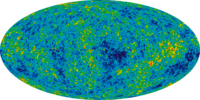
Photo from wikipedia
Abstract Angular temperature fluctuations in a photon gas generate fractional polarization of the black-body spectrum. The spectral density consists of two Planckians with different temperature variables representing orthogonal polarization states.… Click to show full abstract
Abstract Angular temperature fluctuations in a photon gas generate fractional polarization of the black-body spectrum. The spectral density consists of two Planckians with different temperature variables representing orthogonal polarization states. The angular-dependent fluctuating temperature variables can be inferred from the Stokes parameters which have been measured, over the full solid angle, for the cosmic microwave background (CMB) radiation. The polarization matrix of a partially polarized photon gas is obtained by way of a unitary transformation of the annihilation and creation operators. The radiation is decomposed into a totally polarized and an unpolarized intensity component, and the polarization fraction is calculated, which is very small, of order ∼ 1 0 − 7 , for the nearly isotropic CMB radiation. Spatial energy density autocorrelations induced by polarization and temperature anisotropy are derived and isotropized by an angular average. These correlations are long-range, exhibiting power-law decay ∝ 1 ∕ r 6 at large distance, and much stronger than the energy density correlation of an ideal photon gas which decays ∝ 1 ∕ r 8 . As for the CMB radiation, the spatial energy density correlations are calculated from analytic Gaussian fits to the measured temperature and polarization power spectra, including the crossover from the short-distance regime to the asymptotic power-law decay.
Journal Title: Physica A: Statistical Mechanics and its Applications
Year Published: 2019
Link to full text (if available)
Share on Social Media: Sign Up to like & get
recommendations!